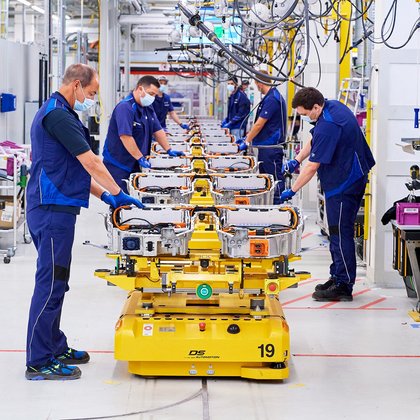Felxibility for electromobility

The switch from fossil to electric power presents the automotive industry with major challenges. Demand for batteries as a key component of electromobility is rising rapidly. In its largest European facility alone, a German premium manufacturer is expanding its production capacity for this in several steps to 500,000 units per year and is relying on application-optimized automated guided vehicles from DS AUTOMOTION.
Share article
AGVs from DS AUTOMOTION make vehicle battery assembly more flexible at German premium manufacturer
In the automotive industry, the switch to electric drive has long since begun and the triumph of this emission-free type of drive appears unstoppable. While the development of combustion technology took more than 130 years, the switch to electric drive is expected to take place in just two decades. This puts enormous pressure on automobile manufacturers to innovate, and not just in vehicle development.
The challenge of high-voltage storage
There is also a lot of rethinking to be done in the production facilities for the drive components. The production of high-voltage batteries in particular presents enormous challenges. To meet the stricter carbon dioxide limits imposed by the use of electric cars, enormous quantities of this key component must be produced. This is why automotive manufacturers are investing in the construction of new production lines in which the urgently needed vehicle-specific high-voltage batteries are produced from battery cells, control electronics, cooling systems and housings with a high degree of automation.
Their complex shapes are frequently adapted to new model generations. For this reason, and because the technology for storing electrical energy is constantly being developed, the facilities for battery assembly must also be particularly flexible and adaptable.
Capacity increase in battery assembly
A well-known German premium manufacturer of dynamic cars in all classes is bundling its production expertise for electric drive components and high-voltage storage systems at its largest European production site in Bavaria. More than 230,000 cars rolled off the production line at this facility in 2020, and high-voltage storage systems have already been produced here since the market launch of the first hybrid and all-electric models in 2013.
From 2022, up to 500,000 e-drives are to be manufactured annually at this site. The goal is to transform the site into the technology center of the future for the automotive sector. After all, every second vehicle of this brand is to be electrically powered by 2030.
High flexibility due to AGV
The speed of development is demonstrated by the fact that the high-voltage batteries produced at the E-Drive Production Competence Center since mid-2021 are fifth-generation batteries. Accordingly, the production lines have been designed to be particularly flexible. A high degree of standardization and modularization ensures that different variants can be produced on each of the lines to meet the growing range of electrified vehicle models.
Traditional assembly lines with their fixed conveyors lack the flexibility needed to respond dynamically to the changing requirements of battery assembly.
"In order to achieve this high degree of flexibility, the production line must also offer the possibility to easily and quickly make changes to the transport routes within the facility," confirms Ing. Kurt Ammerstorfer, Division Manager Sales, Product Management and Marketing at DS AUTOMOTION, a leading global manufacturer of automated guided vehicles (AGVs). "Only an automated guided vehicle system offers this flexibility." This means that the routes taken by an assembly during its completion can be adapted to new requirements just as quickly and easily as the dwell time at the individual stations.
Capacity expansion in three steps
The build-up of capacity in battery assembly at the E-Drive Production Competence Center took place gradually in the period from 2018 to 2021 through the construction of three production lines. The first of these produces six battery storage units per hour for hybrid vehicles. The capacity of the second facility, which is two years younger, is almost twice as high with similar space consumption. While energy blocks for hybrid drives are also assembled there, the third facility produces 30 much larger storage assemblies per hour for purely electrically powered vehicles.
While the facilities are each designed differently, they have one thing in common: The battery modules are assembled on automated guided vehicles (AGVs) from the Austrian manufacturer DS AUTOMOTION. "We have had a close partnership with the automotive manufacturer since as early as 1990," confirms Kurt Ammerstorfer. "The latter uses more than 500 of our AGVs in numerous facilities around the world for various purposes."
Application optimized AGV
From preparing the base plate to fitting the cell blocks and battery management systems and making the electrical connections to applying the cover, battery assembly takes place in numerous stations. Many stations are designed as closed robot cells, but in between numerous work steps are also carried out manually. Some stations are also installed several times in order to parallelize processes whose time requirements significantly exceed the cycle time of the other cells, e.g. the initial charging of the energy storage assemblies.
In the automatic stations, the battery modules together with the workpiece carriers are removed from the vehicle to ensure a defined position for processing by the robots, irrespective of any unevenness in the floor. The cramped conditions not only force very tight curve radii, but also make it necessary to turn around in many stations instead of driving through them.
The AGVs must therefore not only be particularly maneuverable, but must also be able to turn at a standstill.
An AGV specially developed by DS AUTOMOTION for battery assembly has established itself as the preferred vehicle type for this application at this car manufacturer. "The AGVs have been in use for several years in all battery assembly lines of this manufacturer worldwide," explains Christoph Salmhofer, Project Manager, DS AUTOMOTION. "For the latest application, they have been further developed to ensure accessibility for maintenance work even when loaded with the largest battery modules."
Proven system approach
In the production facilities for passenger car high-voltage batteries, the AGVs also have to enter the cells in reverse gear, and often in a tight curve. Its differential drive with servomotors not only makes the vehicle very maneuverable. It also enables it to engage reverse gear and turn on the spot. Navigation is track-guided via a magnetic tape. This is glued to the floor, so that adjustments to the travel paths can be made very easily if necessary.
The AGVs charge their batteries via ground contacts during stays in the stations with longer dwell times. The control computers in the vehicles convert the travel orders from the control system above into coordinated movements along predefined points.
Flexible, space-saving and ergonomic
These landmarks include junctions, for example. Although the 31 and 33 AGVs in the two production lines for the hybrid battery storage units essentially run on a closed circuit with a track length of around 300 m, there are no fewer than 33 of these turnouts in the second facility. "This gives the facility enormous flexibility in dynamically adapting the routes," explains Christoph Salmhofer. "For example, any necessary rework can also be carried out without changing the system within the closed production line."
In the latest facility, 50 AGVs of the same type carry the high-voltage batteries for all-electric cars through the automated assembly steps. Following this, 19 AGVs of a further type take over the battery modules automatically. These vehicles travel on a dedicated layout between the manual workstations.
They can place the modules on edge using a tilting mechanism to ensure optimum ergonomics.
Although it is designed for almost three times as many and considerably larger storage modules and contains more than twice as many AGVs as the facility described above, it only requires twice as much space as the latter. "By splitting it into two subsystems, we managed to combine maximum space utilization and optimal ergonomics in this facility," says Christoph Salmhofer. "It therefore also serves as a best practice example for similar future facilities."
Standard for battery assembly
Such are planned on an ongoing basis. This manufacturer alone operates battery module production not only at this site in Lower Bavaria, but also in China and the USA, and is in the process of expanding this to two further sites in Germany.
"The other German premium manufacturers are also in the process of increasing their battery assembly capacities," confirms Kurt Ammerstorfer. "Most of them are using AGVs from DS AUTOMOTION for this purpose. These have established themselves as the de facto standard in this segment."
